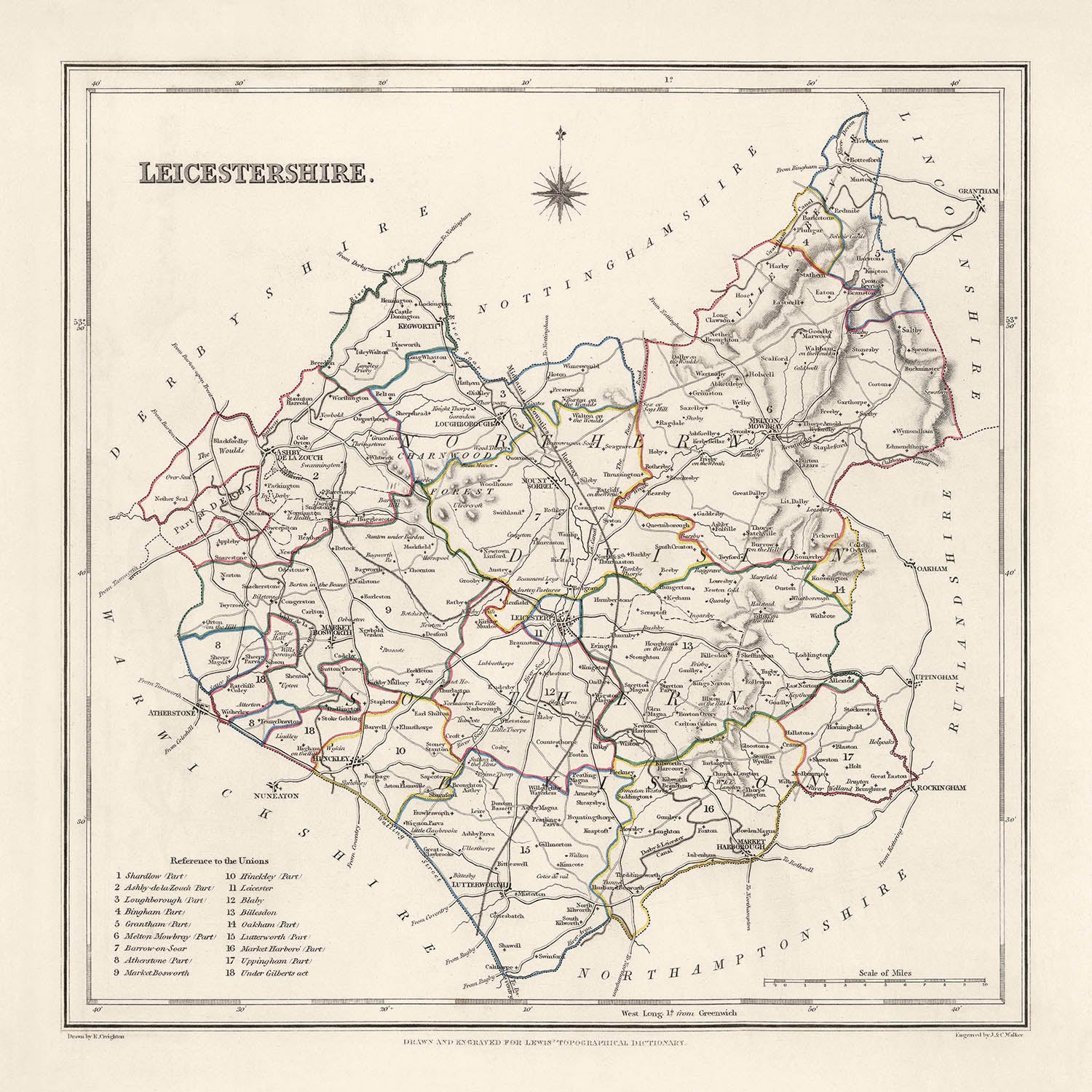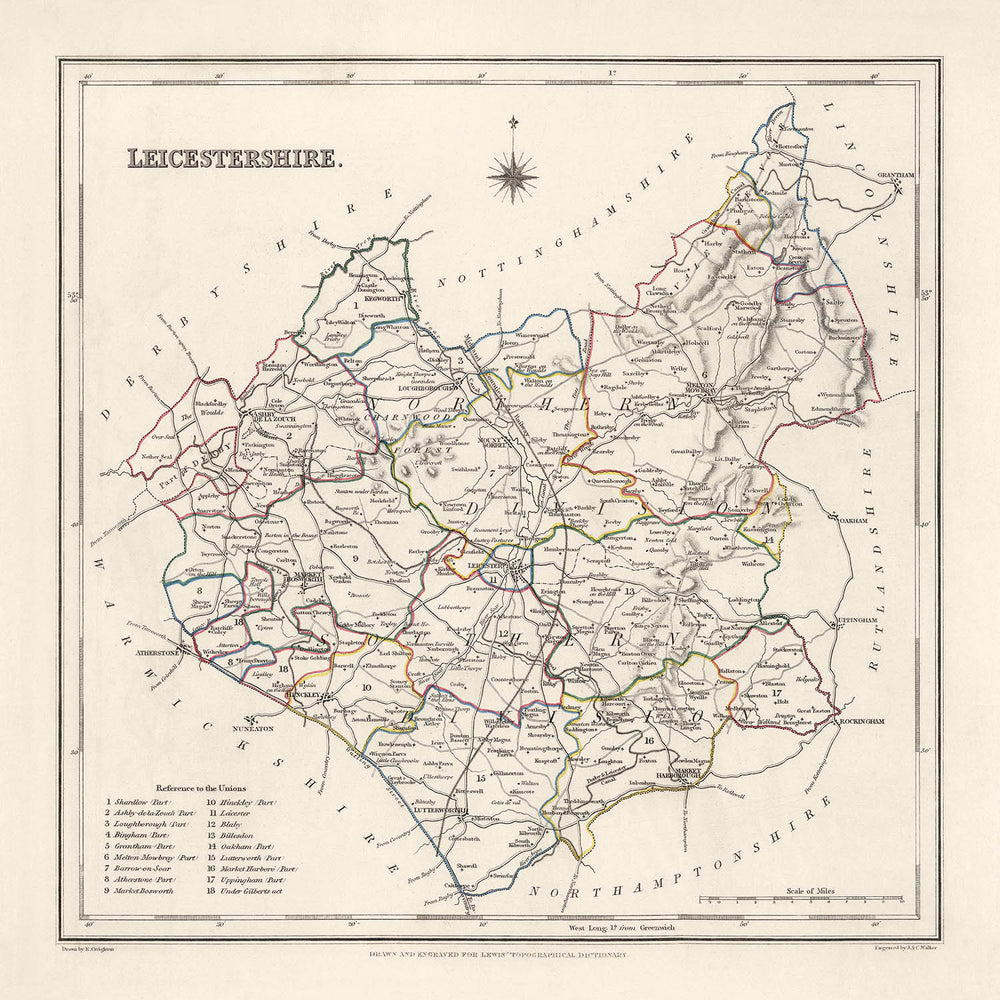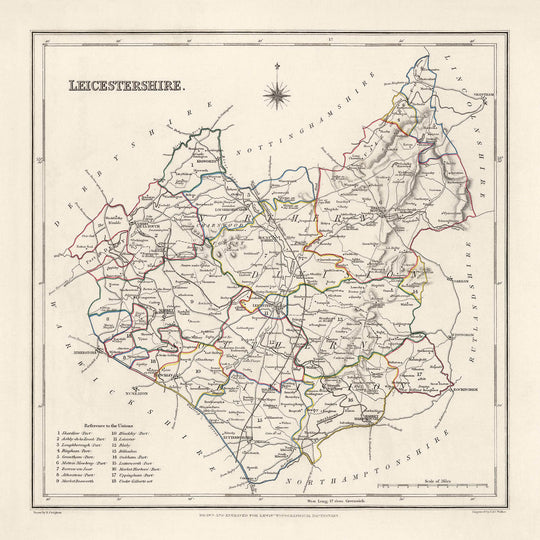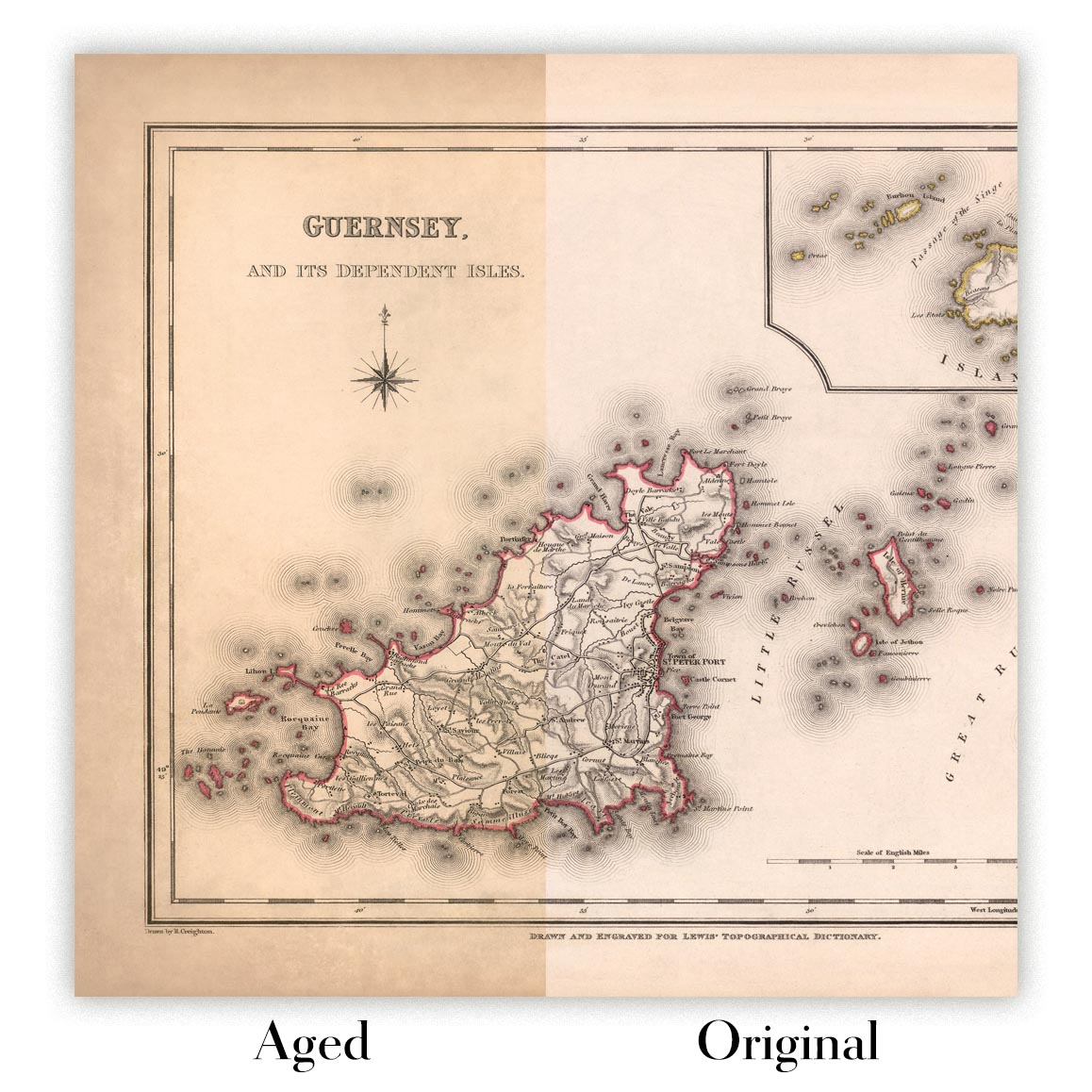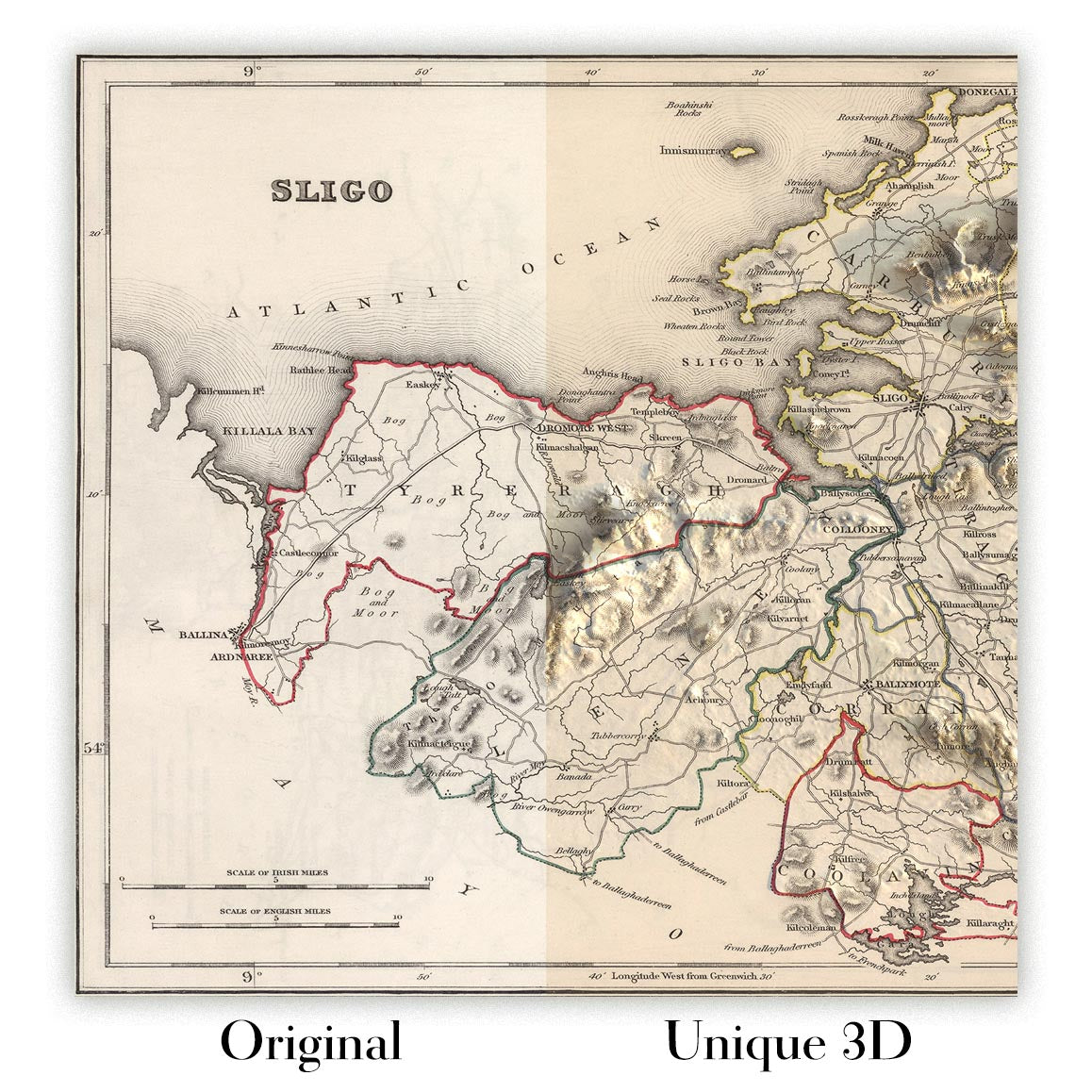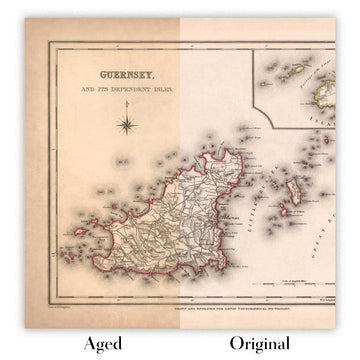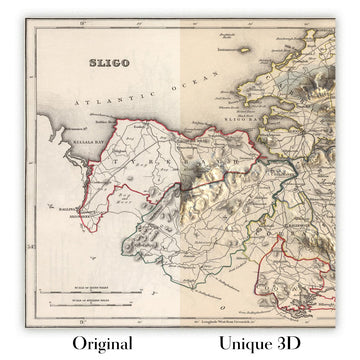- Handmade locally. No import duty or tax
- FREE worldwide delivery
- Love it or your money back (90 days)
- Questions? WhatsApp me any time
Own a piece of history
5,000+ 5 star reviews


This Old Map of Leicestershire by Samuel Lewis in 1844 showcases the historical boundaries of the county, providing a fascinating glimpse into the past. With its intricate details and exquisite cartographic craftsmanship, this map offers a unique opportunity to explore the region as it stood over 175 years ago.
One of the captivating aspects of this map is its representation of the major towns and cities of Leicestershire during the mid-19th century. It is important to note that some modern cities may not be featured on this map, while others may appear under earlier names, adding an element of historical intrigue. By examining this map, you can uncover how these urban centers have evolved and appreciate the rich history they hold.
Within the historical boundaries of the County of Leicestershire, numerous notable settlements and colonies were founded before 1840. Here are 30 such locations, listed in order of modern-day population size, along with their founding year and a brief description of their significance:
- Leicester (50 AD): Founded by the Romans, Leicester boasts a rich history dating back to ancient times. Today, it is a vibrant city with a blend of historical and modern attractions.
- Loughborough (1086): Originating from the Domesday Book, Loughborough is renowned for its prestigious university and industrial heritage.
- Hinckley (1086): Tracing its roots to the Domesday Book, Hinckley is known for its hosiery industry and historical market.
- Melton Mowbray (1086): With a history dating back to the Domesday Book, Melton Mowbray is famous for its culinary delights, particularly the traditional pork pie.
- Coalville (1832): Established during the Industrial Revolution, Coalville played a significant role in the coal mining industry of Leicestershire.
- Wigston Magna (1086): A settlement with medieval origins, Wigston Magna is now a thriving suburban town.
- Oadby (1086): Dating back to the Domesday Book, Oadby is notable for its picturesque parks and gardens.
- Lutterworth (1086): Founded in the medieval period, Lutterworth is renowned as the birthplace of the translation of the Bible by John Wycliffe.
- Market Harborough (1204): Originating from the granting of a market charter, Market Harborough is a charming market town with a rich history.
- Shepshed (1086): With roots in the Domesday Book, Shepshed has a history intertwined with the wool and hosiery industries.
- Syston (1086): Tracing its origins to the Domesday Book, Syston is a town known for its railway heritage.
- Ashby-de-la-Zouch (1086): Dating back to the Domesday Book, Ashby-de-la-Zouch is famed for its medieval castle and picturesque streets.
- Burbage (1086): With a history reaching back to the Domesday Book, Burbage is a village known for its traditional charm.
- Countesthorpe (1086): Originating from the Domesday Book, Countesthorpe is a village surrounded by beautiful countryside.
- Groby (1086): Tracing its roots to the Domesday Book, Groby is notable for its ancient woodland and historic connections.
- Birstall (1086): Dating back to the Domesday Book, Birstall is known for its historic parish church and picturesque setting.
- Quorn (1086): With origins in the Domesday Book, Quorn is a village renowned for its picturesque landscapes and association with fox hunting.
- Mountsorrel (1086): Originating from the Domesday Book, Mountsorrel is a village nestled along the River Soar, offering scenic views.
- Anstey (1086): Tracing its roots to the Domesday Book, Anstey is a village known for its traditional architecture and charming atmosphere.
- Rothley (1086): Dating back to the Domesday Book, Rothley is a village with a rich history and beautiful countryside surroundings.
- Desford (1086): With origins in the Domesday Book, Desford is a village renowned for its rural charm and proximity to nature.
- Castle Donington (1086): Originating from the Domesday Book, Castle Donington is a village known for its historic castle ruins and proximity to East Midlands Airport.
- Barrow upon Soar (1086): Tracing its roots to the Domesday Book, Barrow upon Soar is a village situated on the banks of the River Soar, offering scenic beauty.
- Enderby (1086): Dating back to the Domesday Book, Enderby is a village with a rich history and connections to the textile industry.
- Kibworth (1086): With origins in the Domesday Book, Kibworth is a village known for its picturesque landscapes and historical significance.
- Measham (1086): Originating from the Domesday Book, Measham is a village with a history closely tied to the coal mining industry.
- Glenfield (1086): Tracing its roots to the Domesday Book, Glenfield is a village known for its tranquil setting and historical connections.
- Kirby Muxloe (1086): Dating back to the Domesday Book, Kirby Muxloe is a village famed for its impressive moated castle ruins.
- Earl Shilton (1086): With origins in the Domesday Book, Earl Shilton is a village known for its textile heritage and traditional market.
- Markfield (1086): Originating from the Domesday Book, Markfield is a village nestled within scenic countryside, offering a peaceful retreat.
Notable natural features and tourist attractions in modern-day Leicestershire include the River Soar, Charnwood Forest, Bradgate Park, and the National Forest. These locations provide opportunities for outdoor activities, exploration, and a chance to appreciate the region's natural beauty.
Between 1800 and 1850, Leicestershire witnessed several significant historical events. These include the rise of the textile industry, the expansion of the railway network, the impact of the Industrial Revolution on the county's economy, and the social changes brought about by urbanization.
Owning this Old Map of Leicestershire by Samuel Lewis from 1844 allows you to delve into the historical past of the county, explore its notable settlements, and appreciate the captivating beauty of the region as it stood over 175 years ago.
Please double check the images to make sure that a specific town or place is shown on this map. You can also get in touch and ask us to check the map for you.
This map looks great at all sizes: 12x16in (30.5x41cm), 16x20in (40.5x51cm), 18x24in (45.5x61cm), 24x30in (61x76cm), 32x40in (81.5x102cm) and 40x50in (102x127cm), but it looks even better when printed large.
I can create beautiful, large prints of this map up to 50in (127cm). Please get in touch if you're looking for larger, customised or different framing options.
The model in the listing images is holding the 16x20in (40.5x51cm) version of this map.
The fifth listing image shows an example of my map personalisation service.
Please note the unframed 24x30in (61x76cm) map has white edges around the map. These edges can help you with framing, or if you don’t need them they are very easy to snip off with scissors. All other maps, including the framed maps, look exactly like the listing images.
If you’re looking for something slightly different, check out my main collection of UK and Ireland maps.
Please contact me to check if a certain location, landmark or feature is shown on this map.
This would make a wonderful birthday, Christmas, Father's Day, work leaving, anniversary or housewarming gift for someone from the areas covered by this map.
This map is available as a giclée print on acid free archival matte paper, or you can buy it framed. The frame is a nice, simple black frame that suits most aesthetics. Please get in touch if you'd like a different frame colour or material. My frames are glazed with super-clear museum-grade acrylic (perspex/acrylite), which is significantly less reflective than glass, safer, and will always arrive in perfect condition.
This map is also available as a float framed canvas, sometimes known as a shadow gap framed canvas or canvas floater. The map is printed on artist's cotton canvas and then stretched over a handmade box frame. We then "float" the canvas inside a wooden frame, which is available in a range of colours (black, dark brown, oak, antique gold and white). This is a wonderful way to present a map without glazing in front. See some examples of float framed canvas maps and explore the differences between my different finishes.
For something truly unique, this map is also available in "Unique 3D", our trademarked process that dramatically transforms the map so that it has a wonderful sense of depth. We combine the original map with detailed topography and elevation data, so that mountains and the terrain really "pop". For more info and examples of 3D maps, check my Unique 3D page.
For most orders, delivery time is about 3 working days. Personalised and customised products take longer, as I have to do the personalisation and send it to you for approval, which usually takes 1 or 2 days.
Please note that very large framed orders usually take longer to make and deliver.
If you need your order to arrive by a certain date, please contact me before you order so that we can find the best way of making sure you get your order in time.
I print and frame maps and artwork in 23 countries around the world. This means your order will be made locally, which cuts down on delivery time and ensures that it won't be damaged during delivery. You'll never pay customs or import duty, and we'll put less CO2 into the air.
All of my maps and art prints are well packaged and sent in a rugged tube if unframed, or surrounded by foam if framed.
I try to send out all orders within 1 or 2 days of receiving your order, though some products (like face masks, mugs and tote bags) can take longer to make.
If you select Express Delivery at checkout your order we will prioritise your order and send it out by 1-day courier (Fedex, DHL, UPS, Parcelforce).
Next Day delivery is also available in some countries (US, UK, Singapore, UAE) but please try to order early in the day so that we can get it sent out on time.
My standard frame is a gallery style black ash hardwood frame. It is simple and quite modern looking. My standard frame is around 20mm (0.8in) wide.
I use super-clear acrylic (perspex/acrylite) for the frame glass. It's lighter and safer than glass - and it looks better, as the reflectivity is lower.
Six standard frame colours are available for free (black, dark brown, dark grey, oak, white and antique gold). Custom framing and mounting/matting is available if you're looking for something else.
Most maps, art and illustrations are also available as a framed canvas. We use matte (not shiny) cotton canvas, stretch it over a sustainably sourced box wood frame, and then 'float' the piece within a wood frame. The end result is quite beautiful, and there's no glazing to get in the way.
All frames are provided "ready to hang", with either a string or brackets on the back. Very large frames will have heavy duty hanging plates and/or a mounting baton. If you have any questions, please get in touch.
See some examples of my framed maps and framed canvas maps.
Alternatively, I can also supply old maps and artwork on canvas, foam board, cotton rag and other materials.
If you want to frame your map or artwork yourself, please read my size guide first.
My maps are extremely high quality reproductions of original maps.
I source original, rare maps from libraries, auction houses and private collections around the world, restore them at my London workshop, and then use specialist giclée inks and printers to create beautiful maps that look even better than the original.
My maps are printed on acid-free archival matte (not glossy) paper that feels very high quality and almost like card. In technical terms the paper weight/thickness is 10mil/200gsm. It's perfect for framing.
I print with Epson ultrachrome giclée UV fade resistant pigment inks - some of the best inks you can find.
I can also make maps on canvas, cotton rag and other exotic materials.
Learn more about The Unique Maps Co.
Map personalisation
If you're looking for the perfect anniversary or housewarming gift, I can personalise your map to make it truly unique. For example, I can add a short message, or highlight an important location, or add your family's coat of arms.
The options are almost infinite. Please see my map personalisation page for some wonderful examples of what's possible.
To order a personalised map, select "personalise your map" before adding it to your basket.
Get in touch if you're looking for more complex customisations and personalisations.
Map ageing
I have been asked hundreds of times over the years by customers if they could buy a map that looks even older.
Well, now you can, by selecting Aged before you add a map to your basket.
All the product photos you see on this page show the map in its Original form. This is what the map looks like today.
If you select Aged, I will age your map by hand, using a special and unique process developed through years of studying old maps, talking to researchers to understand the chemistry of aging paper, and of course... lots of practice!
If you're unsure, stick to the Original colour of the map. If you want something a bit darker and older looking, go for Aged.
If you are not happy with your order for any reason, contact me and I'll get it fixed ASAP, free of charge. Please see my returns and refund policy for more information.
I am very confident you will like your restored map or art print. I have been doing this since 1984. I'm a 5-star Etsy seller. I have sold tens of thousands of maps and art prints and have over 5,000 real 5-star reviews. My work has been featured in interior design magazines, on the BBC, and on the walls of dozens of 5-star hotels.
I use a unique process to restore maps and artwork that is massively time consuming and labour intensive. Hunting down the original maps and illustrations can take months. I use state of the art and eye-wateringly expensive technology to scan and restore them. As a result, I guarantee my maps and art prints are a cut above the rest. I stand by my products and will always make sure you're 100% happy with what you receive.
Almost all of my maps and art prints look amazing at large sizes (200cm, 6.5ft+) and I can frame and deliver them to you as well, via special oversized courier. Contact me to discuss your specific needs.
Or try searching for something!







